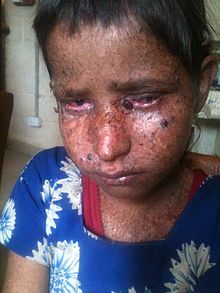Xeroderma pigmentosum


Xeroderma pigmentosum is a rare genetic disorder.
Ultraviolet (UV) light damages the DNA in skin cells. Normally the DNA damage is repaired. But if a person has a defective repair gene, the DNA is not repaired.[1]
Consequences
This disease causes the skin to be sensitive to sunlight.[1] A person with this disorder must always stay out of the sun, or they will get a sunburn. People with this disease are often called a "Moon child" because they can only go outside during the night.[2] This disease is present in both genders and in all races, with one in 250,000 people living in the US having this disease.[3] A Japanese person is about six times more likely to have this disease.[4]
This disorder is found in one in 250,000 people.[5] People with xeroderma pigmentosum are about 1,000 times more likely to get skin cancer.
There is no cure for xeroderma pigmentosum. The symptoms can be minimized if you do not go outside into sunlight. Fewer than 40% of individuals with the disease survive beyond the age of 20. Some XP victims with less severe cases do manage to live well into their 40s.
People that have xeroderma pigmentosum are sensitive to UV light from the sun, and have dry, flaking skin and pigmented spots that can become skin cancer.
Other symptoms include:
- Sunburn when in sunlight.
- Making of freckles at a young age
- Skin cancer
- Eyes that are sensitive to the sun and are irritated and clouded
- Blistering of the skin
- Limited growth of hair on the chest and legs
- Dry, scaly skin
The most important part of treatment is avoiding going into sunlight. You may have to wear protective clothes and wear sunscreen.[6]
Technical note
XP can be caused by mutations in any one of eight genes. Seven of these genes help repair of ultraviolet-induced photoproducts.[7]
References
- ↑ 1.0 1.1 James, William; Berger, Timothy; Elston, Dirk 2005. Andrews' Diseases of the Skin: Clinical Dermatology. 10th ed, Saunders, p574. ISBN 0-7216-2921-0
- ↑ Medical Biochemistry at a Glance. John Wiley. 28 November 2011. ISBN 978-1118292402. Retrieved 17 June 2011.
Xeroderma pigmentosa is a rare, autosomal recessive disease caused by a defective UV-specific endonuclease. Patients with mutations are unable to repair DNA damage caused by sunlight and have been described as "children of the night."
- ↑ Lehmann AR, McGibbon D, Stefanini M (2011). "Xeroderma pigmentosum". Orphanet J Rare Dis. 6: 70. doi:10.1186/1750-1172-6-70. PMC 3221642. PMID 22044607.
{cite journal}: CS1 maint: unflagged free DOI (link) - ↑ Li, Lei 2007. Chapter 3 Nucleotide excision repair. In DNA repair, genetic instability, and cancer. World Scientific Publishing. pp. 75–76. ISBN 981-270-014-5
- ↑ Daya-Grosjean L. & Sarasin A. 2014. Mutat Res. 571(1-2): 43-56.
- ↑ Nussbaum, Robert; McInnes, Roderick; Willard, Huntington (21 May 2015). Genetics in Medicine. Elsevier. ISBN 978-14377-0696-3.
- ↑ Stefanini M. & Kraemer KHK 2008. Xeroderma pigmentosum. In Neurocutaneous diseases. Edited by Ruggieri M, Pascual-Castroviejo I, Di Rocco C. Chapter 51: 771-792. [1]